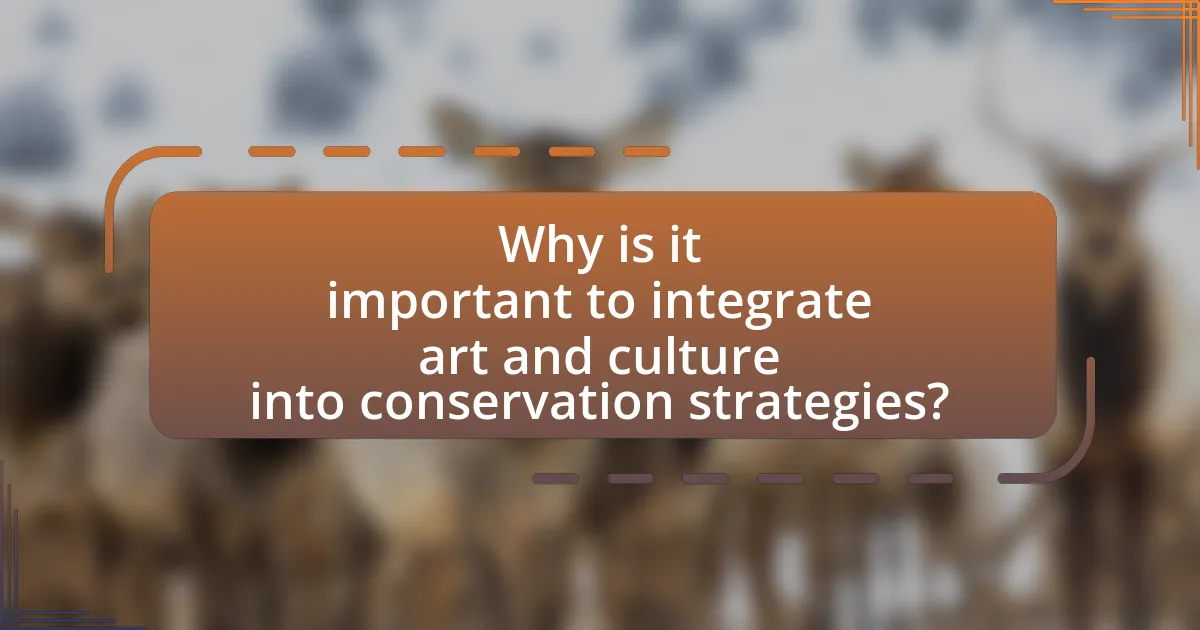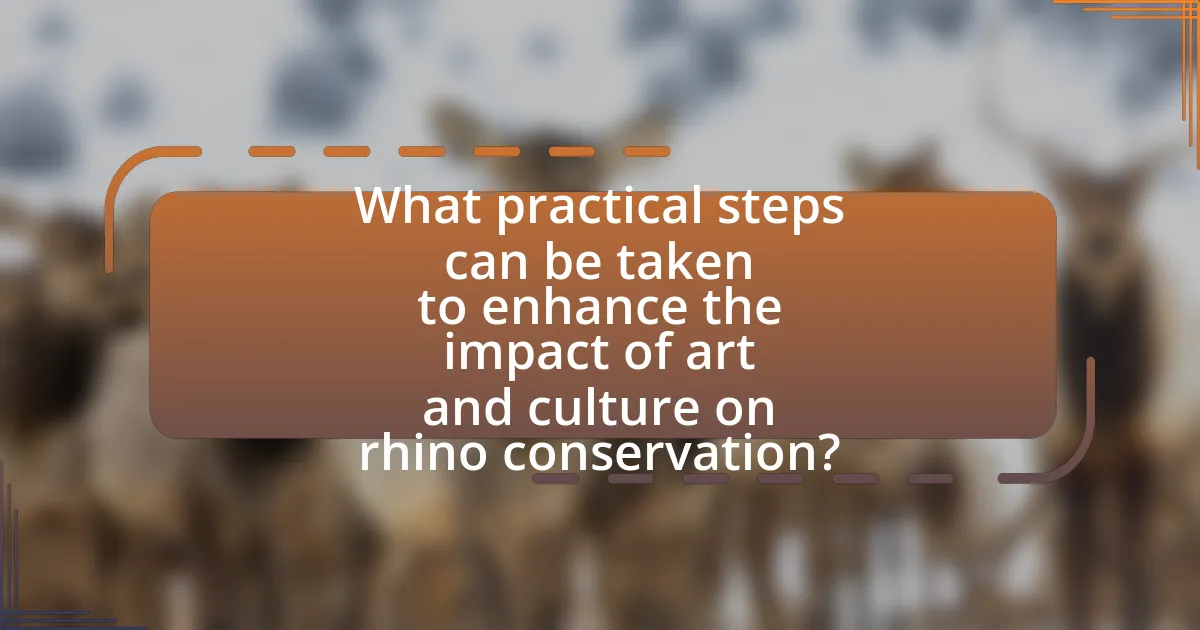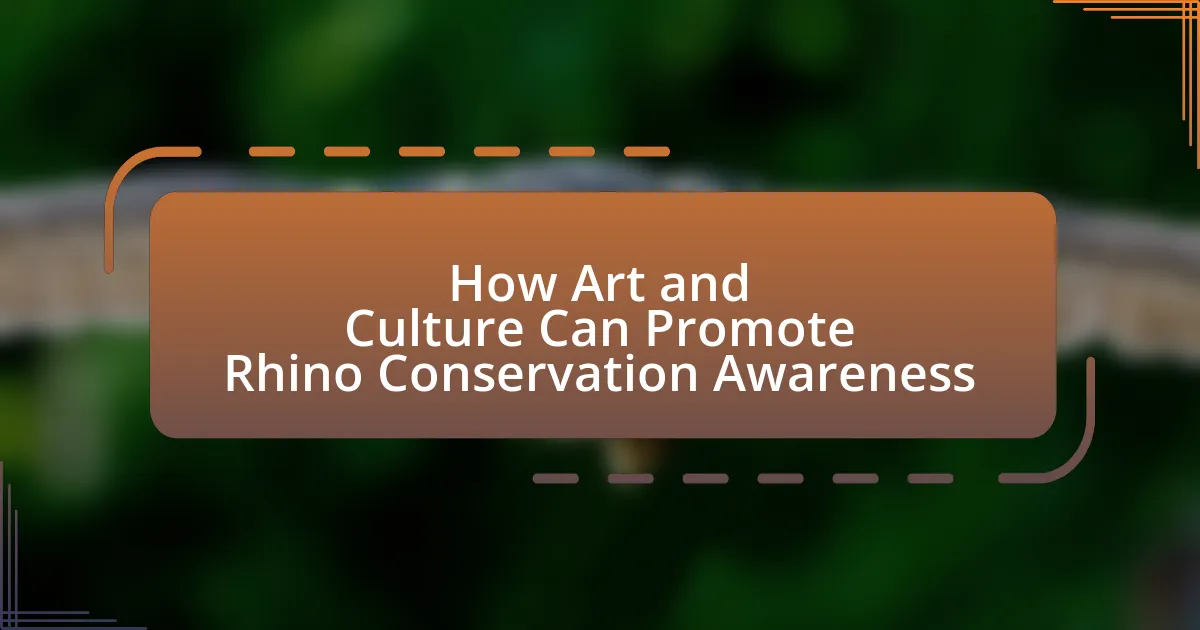The article focuses on the role of art and culture in promoting awareness for rhino conservation. It explores how visual art, cultural events, and storytelling can emotionally engage the public, highlighting the threats faced by rhinos and fostering community responsibility. Key initiatives, such as the “Rhino Art” project and various cultural performances, demonstrate the effectiveness of artistic expression in mobilizing support for conservation efforts. The article also addresses challenges and best practices for integrating art into conservation strategies, emphasizing the importance of collaboration between artists and conservation organizations to enhance public engagement and advocacy for rhino protection.

How can art and culture raise awareness for rhino conservation?
Art and culture can raise awareness for rhino conservation by using creative expressions to highlight the plight of rhinos and engage the public emotionally. For instance, visual art, such as paintings and sculptures, can depict the beauty of rhinos and the threats they face, making the issue more relatable and urgent. Additionally, cultural events like music festivals or theater productions can incorporate themes of conservation, reaching diverse audiences and fostering a sense of community responsibility.
Evidence of this impact is seen in initiatives like the “Rhino Art” project, which has involved artists creating works that raise funds and awareness for rhino protection efforts. Furthermore, campaigns that utilize social media platforms to share artistic content related to rhinos have shown increased engagement and support for conservation efforts, demonstrating the effectiveness of art and culture in mobilizing public action.
What role does visual art play in promoting rhino conservation?
Visual art plays a significant role in promoting rhino conservation by raising awareness and fostering emotional connections to the plight of rhinos. Through powerful imagery and creative expression, artists can convey the urgency of conservation efforts, making the issue more relatable and compelling to the public. For instance, exhibitions featuring rhino-themed artwork have been shown to attract attention and generate discussions about wildlife protection, leading to increased support for conservation initiatives. Studies indicate that visual art can effectively engage audiences, prompting them to take action, such as donating to conservation organizations or participating in advocacy campaigns.
How can artists effectively convey the message of rhino conservation through their work?
Artists can effectively convey the message of rhino conservation through their work by utilizing visual storytelling, emotional engagement, and educational elements. Visual storytelling allows artists to depict the beauty and plight of rhinos, creating compelling imagery that resonates with audiences. Emotional engagement can be achieved through powerful narratives that highlight the impact of poaching and habitat loss on rhinos, fostering empathy and a sense of urgency. Educational elements, such as incorporating facts about rhino populations and conservation efforts, can inform viewers and inspire action. For instance, a study by the World Wildlife Fund indicates that art can significantly raise awareness and funds for conservation initiatives, demonstrating the effectiveness of artistic expression in promoting environmental causes.
What are some notable art projects focused on rhino conservation?
Notable art projects focused on rhino conservation include the “Rhino Charge,” an annual fundraising event in Kenya that combines off-road racing with art installations to raise awareness and funds for rhino protection. Another significant project is “The Rhino Project,” which features large-scale public art installations created by various artists to highlight the plight of rhinos and promote conservation efforts. Additionally, the “Save the Rhino” initiative collaborates with artists to produce limited edition prints and artworks, with proceeds directly supporting rhino conservation programs. These projects effectively engage the public and raise awareness about the critical need for rhino conservation.
In what ways can cultural events support rhino conservation efforts?
Cultural events can support rhino conservation efforts by raising awareness, generating funding, and fostering community engagement. These events, such as art exhibitions, music festivals, and cultural festivals, often attract diverse audiences, providing a platform to educate attendees about the threats facing rhinos and the importance of conservation. For instance, the “Rhino Charge,” an annual off-road motorsport event in Kenya, raises significant funds for rhino conservation projects, with over $6 million raised since its inception in 1998. Additionally, cultural events can create partnerships between local communities and conservation organizations, encouraging sustainable practices and promoting the value of wildlife tourism. By integrating conservation messages into cultural programming, these events can effectively mobilize public support and action for rhino protection.
How do festivals and exhibitions contribute to raising awareness about rhinos?
Festivals and exhibitions significantly raise awareness about rhinos by providing a platform for education, engagement, and advocacy. These events often feature art, performances, and informational displays that highlight the plight of rhinos, drawing attention to their endangered status. For instance, events like World Rhino Day include activities that educate attendees about poaching and habitat loss, fostering a sense of urgency and responsibility towards conservation efforts. Additionally, exhibitions can showcase the work of conservation organizations, allowing attendees to learn about ongoing initiatives and how they can contribute. This combination of artistic expression and factual information effectively mobilizes public interest and support for rhino conservation.
What types of cultural performances can highlight the importance of rhino conservation?
Cultural performances that can highlight the importance of rhino conservation include traditional dances, theater productions, music festivals, and storytelling events. These performances serve as platforms to educate audiences about the threats faced by rhinos and the significance of their conservation. For instance, traditional dances often incorporate themes of nature and wildlife, fostering a connection between the community and the environment. Theater productions can dramatize the plight of rhinos, making the issue relatable and urgent. Music festivals can feature songs that raise awareness about conservation efforts, while storytelling events can share indigenous knowledge and cultural narratives that emphasize the value of rhinos in ecosystems. Such performances not only entertain but also inform and inspire action towards rhino conservation.

Why is it important to integrate art and culture into conservation strategies?
Integrating art and culture into conservation strategies is important because it enhances public engagement and emotional connection to conservation efforts. Art and cultural expressions can effectively communicate the significance of biodiversity and the urgency of conservation, making complex issues more relatable and inspiring action. For instance, initiatives like the “Rhino Art” project have successfully used artistic representations to raise awareness about rhino poaching, leading to increased community involvement and support for conservation measures. This approach not only educates the public but also fosters a sense of shared responsibility, ultimately contributing to more effective conservation outcomes.
How does art influence public perception of rhinos and their conservation?
Art significantly influences public perception of rhinos and their conservation by evoking emotional responses and raising awareness about their plight. Through visual representations, literature, and performance, art can highlight the beauty and majesty of rhinos, fostering empathy and a sense of urgency regarding their endangered status. For instance, campaigns featuring powerful imagery of rhinos have been shown to increase public engagement and support for conservation efforts, as evidenced by initiatives like the “Save the Rhino” art exhibitions, which have successfully raised funds and awareness. Additionally, art can serve as a platform for storytelling, allowing artists to share narratives that connect audiences to the realities of rhino poaching and habitat loss, thereby motivating action and advocacy for conservation.
What psychological effects does art have on people’s attitudes towards wildlife conservation?
Art significantly influences people’s attitudes towards wildlife conservation by evoking emotional responses and fostering empathy. Through visual imagery, storytelling, and immersive experiences, art can create a deeper connection between individuals and wildlife, making the issues surrounding conservation more relatable and urgent. Research indicates that emotionally charged art can lead to increased awareness and motivation to engage in conservation efforts. For instance, a study published in the journal “Conservation Biology” found that participants exposed to impactful wildlife art reported higher levels of concern for endangered species and a greater willingness to support conservation initiatives. This demonstrates that art serves as a powerful tool in shaping public perception and encouraging proactive behaviors towards wildlife conservation.
How can storytelling through art create emotional connections to rhino conservation?
Storytelling through art creates emotional connections to rhino conservation by humanizing the plight of rhinos and illustrating their struggles through relatable narratives. Art can depict the beauty and majesty of rhinos, evoking empathy and a sense of urgency in viewers. For instance, visual art installations and performances that showcase the impact of poaching and habitat loss can lead to a deeper understanding of the consequences of these actions. Research indicates that emotional engagement significantly influences conservation behavior; a study published in the journal “Conservation Biology” found that emotionally charged narratives can increase public support for conservation initiatives. Thus, storytelling through art not only raises awareness but also fosters a personal connection that motivates individuals to take action for rhino conservation.
What are the challenges of using art and culture in conservation awareness?
The challenges of using art and culture in conservation awareness include the difficulty in effectively communicating complex ecological issues and the potential for misinterpretation of artistic messages. Art often simplifies or abstracts environmental problems, which can lead to a lack of understanding among audiences about the specific threats faced by species like rhinos. Additionally, cultural differences can influence how art is perceived, resulting in varied interpretations that may not align with the intended conservation message. For instance, a study by the World Wildlife Fund highlights that while art can engage emotions, it may not always convey actionable information necessary for conservation efforts.
How can artists overcome barriers to effectively communicate conservation messages?
Artists can overcome barriers to effectively communicate conservation messages by utilizing relatable narratives and engaging visual storytelling. By creating art that resonates with audiences on an emotional level, artists can foster a deeper connection to conservation issues. For instance, studies show that emotional engagement significantly enhances the retention of conservation messages, making them more impactful. Additionally, collaborating with conservation organizations can provide artists with accurate information and resources, ensuring that their messages are both compelling and factually correct. This approach not only amplifies the reach of the conservation message but also builds credibility, as evidenced by successful campaigns that have integrated art to raise awareness about endangered species, including rhinos.
What criticisms exist regarding the use of art in conservation efforts?
Criticisms regarding the use of art in conservation efforts include concerns about oversimplification of complex issues and the potential for art to distract from scientific data. Critics argue that while art can evoke emotional responses, it may not effectively convey the nuanced realities of conservation challenges, such as habitat loss and poaching. Additionally, some believe that art can lead to a superficial understanding of conservation, where aesthetic appeal overshadows the need for actionable solutions. This perspective is supported by studies indicating that emotional engagement through art does not always translate into long-term behavioral change or support for conservation initiatives.

What practical steps can be taken to enhance the impact of art and culture on rhino conservation?
To enhance the impact of art and culture on rhino conservation, organizations can implement community art projects that raise awareness about rhino poaching and habitat loss. These projects can include murals, sculptures, and performances that depict the significance of rhinos in ecosystems, thereby fostering a connection between the community and wildlife. For instance, the “Rhino Art Project” in South Africa has successfully engaged local artists to create public artworks that educate the public about rhino conservation, leading to increased community involvement and support for conservation efforts. Additionally, cultural festivals can be organized to celebrate wildlife, featuring art exhibitions, storytelling, and workshops that highlight the importance of rhinos, which can attract media attention and funding for conservation initiatives.
How can communities engage local artists in conservation initiatives?
Communities can engage local artists in conservation initiatives by organizing collaborative projects that highlight environmental themes, such as mural painting or public art installations focused on wildlife conservation. These projects can raise awareness about specific issues, like rhino conservation, by visually representing the importance of protecting these animals and their habitats. For instance, a study by the World Wildlife Fund indicates that art can effectively communicate conservation messages and inspire community action, as seen in successful campaigns that utilized local artists to create impactful visual narratives.
What collaborative projects can be developed between artists and conservation organizations?
Collaborative projects between artists and conservation organizations can include public art installations that raise awareness about rhino conservation, educational workshops that combine art and environmental science, and fundraising events featuring art auctions to support conservation efforts. For instance, the “Rhino Art Project” in South Africa involved artists creating sculptures that were displayed in public spaces, effectively engaging the community and raising funds for rhino protection initiatives. Such projects not only enhance public visibility of conservation issues but also foster community involvement and support for wildlife preservation.
How can educational programs incorporate art to promote rhino conservation?
Educational programs can incorporate art to promote rhino conservation by integrating creative projects that engage students in understanding the ecological importance of rhinos. For instance, programs can include art workshops where students create paintings, sculptures, or digital art that depict rhinos in their natural habitats, fostering a personal connection to the species. Research shows that visual arts can enhance emotional engagement and retention of information, making the conservation message more impactful. Additionally, educational institutions can host art exhibitions showcasing student work focused on rhino conservation, which can raise awareness in the community and encourage discussions about wildlife protection. This approach not only educates participants about the threats facing rhinos but also empowers them to advocate for conservation through their artistic expressions.
What are some successful examples of art and culture initiatives in rhino conservation?
Successful examples of art and culture initiatives in rhino conservation include the “Rhino Art” project, which engages children in creating art that raises awareness about rhino poaching, and the “Save the Rhino” campaign that utilizes photography and visual storytelling to highlight the plight of rhinos. The Rhino Art project has reached over 10,000 children across South Africa, fostering a sense of responsibility and advocacy among the youth. The Save the Rhino campaign has effectively used social media to amplify its message, resulting in increased public engagement and funding for conservation efforts. These initiatives demonstrate the power of creative expression in mobilizing community support and raising awareness about rhino conservation.
How have specific campaigns utilized art to achieve conservation goals?
Specific campaigns have utilized art to achieve conservation goals by creating impactful visual narratives that raise awareness and inspire action. For instance, the “Rhino Art” campaign involved artists from various backgrounds who created artworks depicting rhinos, which were then displayed in public spaces to engage communities and highlight the plight of these endangered animals. This initiative not only educated the public about rhino conservation but also raised funds for anti-poaching efforts, demonstrating the effectiveness of art in mobilizing support for wildlife protection. Additionally, the “Save the Rhino” campaign has collaborated with artists to produce limited edition prints, with proceeds directly funding conservation projects, thereby linking artistic expression with tangible conservation outcomes.
What lessons can be learned from successful art-based conservation efforts?
Successful art-based conservation efforts demonstrate the importance of community engagement and storytelling in raising awareness. These initiatives often involve local artists collaborating with conservationists to create impactful visual narratives that resonate with the public. For instance, the “Rhino Art” project in South Africa engaged children to paint rhino-themed artworks, which not only educated them about conservation but also fostered a sense of ownership and responsibility towards wildlife. This approach has been shown to increase public interest and support for conservation efforts, as evidenced by a 2019 study published in the Journal of Environmental Psychology, which found that art can significantly enhance emotional connections to conservation issues. Thus, the lessons learned emphasize the effectiveness of integrating art into conservation strategies to inspire action and foster community involvement.
What are the best practices for using art and culture in conservation awareness?
The best practices for using art and culture in conservation awareness include engaging local communities, utilizing storytelling, and collaborating with artists. Engaging local communities ensures that the cultural context is respected and that the messages resonate with the audience, fostering a sense of ownership and responsibility towards conservation efforts. Storytelling through various art forms, such as visual arts, music, and theater, effectively conveys the emotional and ecological significance of conservation, making the issues more relatable and impactful. Collaborating with artists can amplify the reach of conservation messages, as artists often have established platforms and audiences, allowing for broader dissemination of awareness campaigns. These practices have been shown to enhance public engagement and support for conservation initiatives, as evidenced by successful projects like the “Rhino Art” initiative in South Africa, which combines art with education to raise awareness about rhino conservation.
